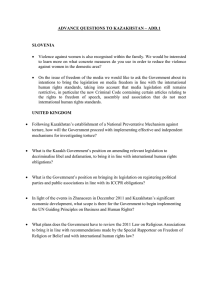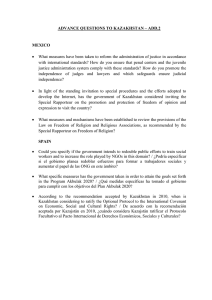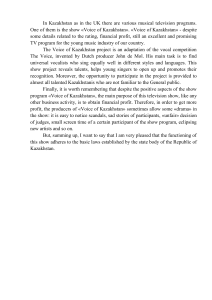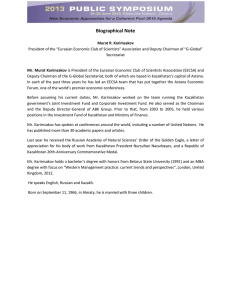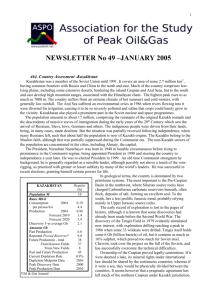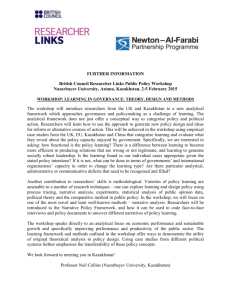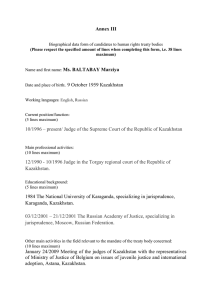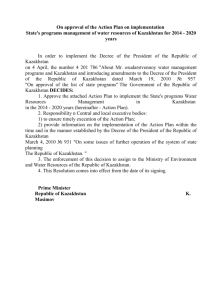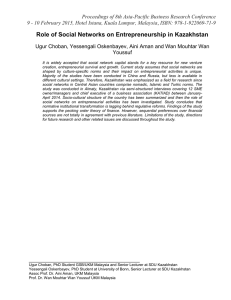KAZAKHSTAN: TRANSPORT SECTOR NOTE
advertisement
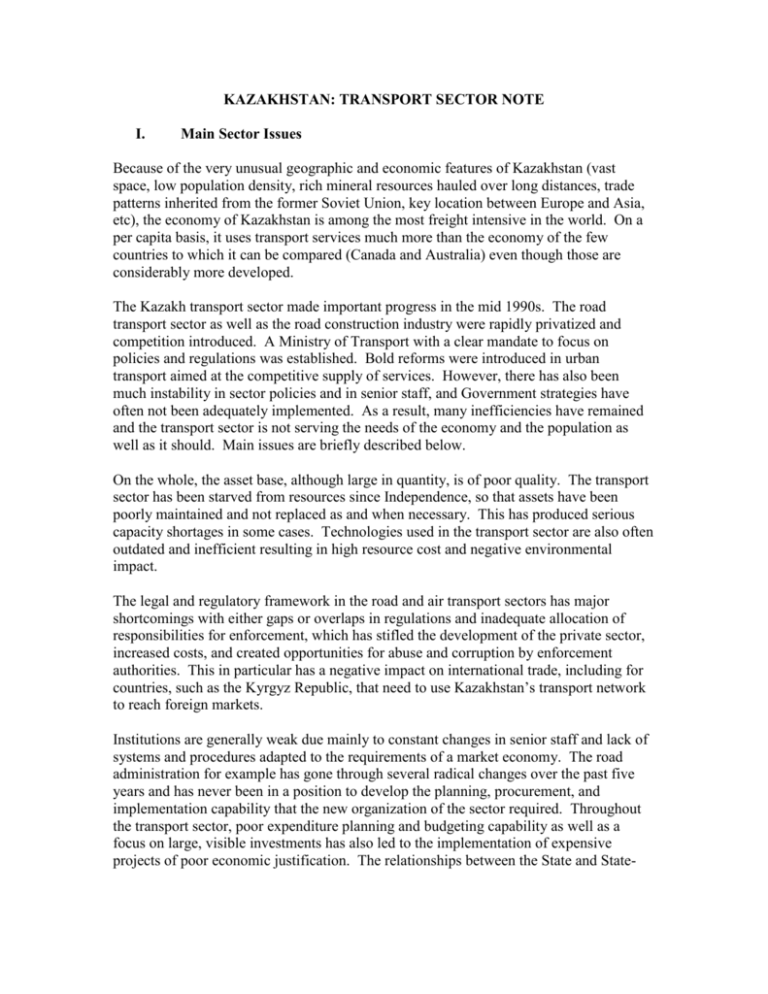
KAZAKHSTAN: TRANSPORT SECTOR NOTE I. Main Sector Issues Because of the very unusual geographic and economic features of Kazakhstan (vast space, low population density, rich mineral resources hauled over long distances, trade patterns inherited from the former Soviet Union, key location between Europe and Asia, etc), the economy of Kazakhstan is among the most freight intensive in the world. On a per capita basis, it uses transport services much more than the economy of the few countries to which it can be compared (Canada and Australia) even though those are considerably more developed. The Kazakh transport sector made important progress in the mid 1990s. The road transport sector as well as the road construction industry were rapidly privatized and competition introduced. A Ministry of Transport with a clear mandate to focus on policies and regulations was established. Bold reforms were introduced in urban transport aimed at the competitive supply of services. However, there has also been much instability in sector policies and in senior staff, and Government strategies have often not been adequately implemented. As a result, many inefficiencies have remained and the transport sector is not serving the needs of the economy and the population as well as it should. Main issues are briefly described below. On the whole, the asset base, although large in quantity, is of poor quality. The transport sector has been starved from resources since Independence, so that assets have been poorly maintained and not replaced as and when necessary. This has produced serious capacity shortages in some cases. Technologies used in the transport sector are also often outdated and inefficient resulting in high resource cost and negative environmental impact. The legal and regulatory framework in the road and air transport sectors has major shortcomings with either gaps or overlaps in regulations and inadequate allocation of responsibilities for enforcement, which has stifled the development of the private sector, increased costs, and created opportunities for abuse and corruption by enforcement authorities. This in particular has a negative impact on international trade, including for countries, such as the Kyrgyz Republic, that need to use Kazakhstan’s transport network to reach foreign markets. Institutions are generally weak due mainly to constant changes in senior staff and lack of systems and procedures adapted to the requirements of a market economy. The road administration for example has gone through several radical changes over the past five years and has never been in a position to develop the planning, procurement, and implementation capability that the new organization of the sector required. Throughout the transport sector, poor expenditure planning and budgeting capability as well as a focus on large, visible investments has also led to the implementation of expensive projects of poor economic justification. The relationships between the State and State- owned enterprises has never been rationalized leading to either excessive interference or loose supervision, especially in the case of the railways and the national airline. Finally, financial policies have often been problematic. Rail passenger tariffs have been highly cross-subsidized by freight tariffs. Air transport fares have been below actual costs. The low taxation of gasoline and diesel oil has also made it impossible for the State to recover the cost of maintaining and rehabilitating the road network. II. Government Strategy The Government strategy in the transport sector has been focused on: developing the institutional and regulatory framework for the competitive and private provision of transport services and transport infrastructure, while ensuring that the State retains for strategic reasons a controlling role in the sector; modernizing the sector particularly through major investments in key infrastructure facilities; developing the role of Kazakhstan as a key transit country between Europe, the former Soviet Union, and Asia; ensuring the lowest possible cost of transport as a way to promote domestic and international trade, and serving the needs of the low income population. III. World Bank Support The Bank financed an early project in urban transport, completed in 1998, which led to major reforms in urban transport policies, including development of the private sector and generalization of competitively tendered bus route franchises. Presently, the Bank is supporting the road and road transport sectors through rehabilitation of the main northsouth road in coordination with the Asian Development Bank and several Arab Funds, and key developments in road administration, road transport regulations, and road safety. The Bank has also initiated support for rural transport, an area that is deemed of key importance for poverty alleviation among the rural population. Other international funding agencies, especially the Asian Development Bank, the European Bank for Reconstruction and Development, and the Japanese Bank for International Cooperation, have also been active in the road, railway, and water transport sectors. A major constraint to the Bank’s present support to the transport sector is the Government’s recent policy to limit as much as possible the use of foreign technical assistance financed by the Bank. As in other Central Asian countries, the facilitation of international trade and transport is of key importance for economic growth, but has not made substantial progress despite the involvement of several donors. Because of its experience in this field in other parts of the world and its relationship with Kazakhstan’s trade and transit partners, the Bank is well placed to help address this issue. Support should start with a joint review of issues and preparation of a strategy together with all those with an interest in trade. It would also need to be coordinated with related initiatives by neighboring countries and other donors.
